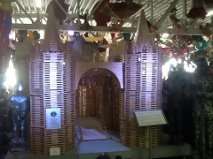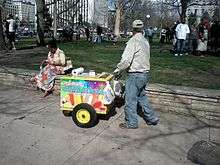Ice pop
 A green ice pop | |
| Alternative names | chihiro, freeze ice, freezer pop, ice lollipop, ice lolly, ice pole, ice pop, paleta, picolé, Popsicle |
|---|---|
| Type | Frozen dessert |
| Place of origin | United States |
| Region or state | California |
| Created by | Frank Epperson |
| Main ingredients | Water, flavoring (such as fruit juices) |
| 200 kcal (837 kJ) | |
An ice pop is a water or milk based frozen snack on a stick.[1] Unlike ice cream which is whipped while freezing to prevent ice crystal formation, an ice pop is quiescently or still frozen and becomes a solid block of ice.[2] The stick is used as a handle to hold it. Without a stick, the frozen product is known as something else (e.g. freezie).
Ice pops can also be referred to as a Popsicle[3][4] (Canada, U.S., New Zealand), freezer pop (U.S.), paleta (Mexico), ice lolly, ice pop (United Kingdom, India, Ireland, South Africa), ice block (New Zealand, parts of Australia), icy pole (parts of Australia), ice drop (Philippines), picolé (Brazil) or chihiro (Cayman Islands).[5]
History
Frank Epperson of Oakland or San Francisco, California, (it is debated where) popularized ice pops after patenting the concept of "frozen ice on a stick" in 1923.[6][7] He initially called it the Epsicle.[8] A couple of years later, Epperson sold the rights to the invention and the Popsicle brand to the Joe Lowe Company in New York City.[6]
Epperson claimed to have first created an ice pop in 1905 at the age of 11 when he accidentally left a glass of powdered soda and water with a mixing stick in it on his porch during a cold night, a story still printed on the back of Popsicle treat boxes.
Terminology

In the United States and Canada frozen ice on a stick is generically referred to as a popsicle due to the early popularity of the Popsicle brand, and the word has become a genericized trademark to mean any ice pop or freezer pop, regardless of brand or format.[9][4][10] (The word is a portmanteau of pop and icicle; the word is genericized to such an extent that there are decades-old derived slang meanings such as "popsicle stand".[11]) They are also called an ice pop or freezer pop in the United States. In the Caicos Islands it is referred to as an ice saver. In the United Kingdom and Ireland the terms ice lolly and ice pop are used, though ice pop is much more common in Ireland. Chihiro is used as a slang term in the Cayman Islands, partially derived from chill.[5] Different parts of Australia use either ice block or icy pole,[12] and New Zealand uses ice block.
Paletas
After a trip to the United States in the early 1940's Ignacio Alcázar returned to his home city of Tocumbo, Michoacán, México[13][14] bringing the idea to manufacture ice pops or paletas (little sticks) using locally available fresh fruit. He and some family members expanded by opening a shop in Mexico City which became very popular[13] and he began to franchise Paletería La Michoacana to friends and family from his town. The popularity of Paletas and association with Tocumbo has increased to the status of a national Mexican food.[15]
Paleta Flavors
Paleta flavors can be divided into two basic categories: milk based or water based. The composition of each flavor may vary, but the base is most often fruit. Paleterias usually have dozens of flavors of paleta including local flavors like horchata, tamarind, mamey and nanche along with other flavors like strawberry, lime, chocolate and mango. Distinctly Mexican ingredients like chili pepper, chamoy, and vanilla are often present in these paletas. Paleterias adapt their flavors to the tastes of the community and local availability of ingredients.
Paletero

A paletero (roughly equivalent to the English "ice cream man"), is a street seller of paletas and other frozen treats, usually from a pushcart labeled with the name of the enterprise that made the paletas (paletería). The pushcart or carrito paletero is more than just a way of delivering paletas to buyers but also represents economic means for new immigrants. One can obtain a pushcart by working for a paleteria or one can buy one independently. Paleteros emerged in the town of Tucumbo in the state of Michoacan, Mexico where much of the population worked in agriculture. Emigrants from the area introduced paletas and paleteros to the United States when they migrated there to work as temporary agricultural workers under the Bracero programs from 1942.
Today, many paleteros (mainly of Mexican descent) continue to sell paletas, often serving low-income communities of color. Paleterias and paleteros are now commonly found in American cities with significant Mexican populations. Paletas are not only a dessert, but reflect the paleteros' own cultural identity, "Carlos finds a little piece of home selling paletas. In a city where 30 percent of the population is Latino, according to the San Jose City demographics website, the Mexican tradition of peddling goods on the street thrives". [16]
Vending requirements for paleteros vary widely by city. In San Jose, California, a permit to sell paletas costs about $154.[17] On average, a paletero makes 40-60 cents from each paleta.[18]
Homemade ice pops
An alternative to the store-bought ice pops is making them at home using fruit juice, drinks, or any freezable beverage. A classic method involves using ice cube trays and toothpicks, although various ice pop freezer molds are also available.[19]
World record ice pop
On June 22, 2005, Snapple tried to beat the existing Guinness World Records entry of a 1997 Dutch 21-foot (6.4 m) ice pop by attempting to erect a 25-foot (7.6 m) ice pop in New York City. The 17.5 short tons (15.9 t) of frozen juice that had been brought from Edison, New Jersey in a freezer truck melted faster than expected, dashing hopes of a new record. Spectators fled to higher ground as firefighters hosed away the melted juice.[20]
See also
- Freezie – a.k.a. ice pole – similar to an ice pop but without the stick
- Ice cream bar - similar to an ice pop but made with ice cream
- Ice cream
- Sorbet
References
- ↑ Hallock, Betty (2007-08-22). "Paletas: Icy, spicy, cool". Los Angeles Times. Retrieved 2018-08-26.
- ↑ "Hawkeshealth.net". Hawkeshealth.net. Retrieved 2011-10-06.
- ↑ "8 Common Words That Are Still Trademarked: Popsicle." at Merriam-Webster.com. Retrieved 10 August 2018.
- 1 2 Mark Abadi. "Taser, Xerox, Popsicle, and 31 more brands-turned-household names." Business Insider. 3 June 2018. Retrieved 10 August 2018.
- 1 2 Miller, Grace (2008). Cayman Culture. London: Penguin Books. p. 142.
- 1 2 Ben Marks (15 August 2012). "The cold, hard truth about popsicles". Collectors Weekly.
- ↑ "Trademark Status & Document Retrieval". tsdr.uspto.gov. Retrieved 2018-06-27.
- ↑ "The popsicle story". Retrieved 23 June 2014.
- ↑ "8 Common Words That Are Still Trademarked: Popsicle." at Merriam-Webster.com. Retrieved 10 August 2018. "It might be surprising, but Popsicle is trademarked..."
- ↑ Martha Cooper and William L. Nothstine. Power Persuasion: Moving an Ancient Art Into the Media Age. Educational Video Group, 1992. ISBN 9780961648930 p. 159: "...what would we call those sweet icy treats on a stick if we did not have the name 'Popsicle'?"
- ↑ Jonathon Green. Cassell's Dictionary of Slang. Sterling Publishing Company, Inc., 2005. ISBN 9780304366361 p. 1123.
- ↑ "Ice block". Encarta Dictionary. MSN Encarta. Archived from the original on 2009-11-01. Retrieved 2008-12-30.
- 1 2 Alarcón, Claudia (2003-09-12). "The Michoacana Connection". The Austin Chronicle. Retrieved 2018-08-26.
- ↑ Graber, Karen Hursh. "Mexican frozen treats: Helados, nieves and paletas : Mexico Cuisine". Mexconnect. Retrieved 2018-08-26.
- ↑ Potter, Cristina (2013-04-20). "Paletas La Michoacana: Big Business, Sweet and Icy in Tocumbo". Mexico Cooks!. Retrieved 2018-08-26.
- ↑ Normand, Vrinda (2002-08-29). "Metroactive News & Issues: Paleteros". Metroactive. Retrieved 2018-08-26.
- ↑ REGULATIONS FOR APPROVED LOCATION PEDDLERS IN THE DOWNTOWN STREET VENDORS PROGRAM AREA (PDF). San Jose, CA USA: City of San Jose.
- ↑ Puig, Claudia (1988-05-29). "San Fernando's Paleteros Reap Sweet Profits but Risk Arrest". Los Angeles Times. Retrieved 2018-08-26.
- ↑ Erin (2012-06-30). "DIY: Toothpick Popsicles with Fruit!". Retrieved 2018-06-29.
- ↑ Associated Press (2005-06-22). "Disaster on a stick: Snapple's attempt at popsicle world record turns into gooey fiasco". MSNBC. Retrieved 2007-06-29.
Further reading
| Wikimedia Commons has media related to Ice lollipops. |
- Andrew F. Smith, ed. (2007). "Popsicle". The Oxford Companion to American Food and Drink. Oxford University Press. p. 471.
- laverrán, Virginia González. "Historia del Helado en México By Martin González de la Vara ." Historia Mexicana 40 .2 (1990 ): 350-354.
- Ortiz, Laura Velasco. "La Michoacana. Historia de Paleteros de Tocombu by Martin González de la Vara ." Historia Mexicana 58.1 (2008): 509-516.
- Zuñiga, Ricardo Miranda. "Vagamundo: A migrant's Tale ." (n.d.).http://dl.acm.org/citation.cfm?id=1027762&bnc=1